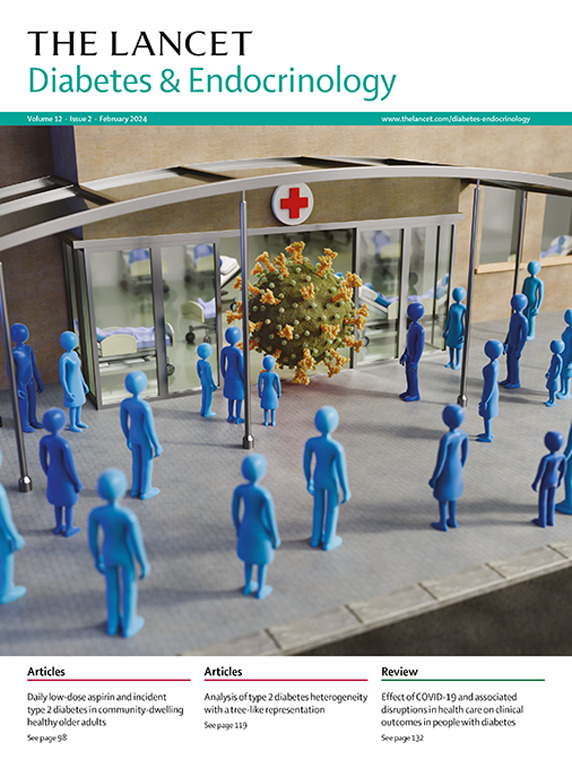Once-weekly semaglutide 7·2 mg in adults with obesity and type 2 diabetes (STEP UP T2D): a randomised, controlled, phase 3b trial
IF 41.8
1区 医学
Q1 ENDOCRINOLOGY & METABOLISM
引用次数: 0
Abstract
Background
Semaglutide 2·4 mg is approved for weight management in adults with obesity or overweight in the presence of at least one obesity-related complication; however, many people with obesity and type 2 diabetes do not reach their bodyweight reduction goals with this dose. We aimed to investigate the efficacy and safety of a new 7·2 mg maintenance dose of once-weekly subcutaneous semaglutide in people with obesity and type 2 diabetes.Methods
STEP UP T2D was a randomised, phase 3b, double-blind controlled, three-arm, parallel-group trial conducted at 68 hospitals, specialist clinics, and medical centres in Bulgaria, Canada, Hungary, Poland, Portugal, Slovakia, South Africa, and the USA. Adults aged 18 years or older (BMI ≥30·0 kg/m2, HbA1c 7·0–10·0% [53–86 mmol/mol]) were randomly assigned (3:1:1) to receive once-weekly subcutaneous semaglutide 7·2 mg, 2·4 mg, or placebo, alongside a lifestyle intervention, for 72 weeks. Coprimary endpoints were the percentage change in bodyweight and the proportion of participants reaching a bodyweight reduction of 5% or greater with semaglutide 7·2 mg versus placebo. Confirmatory secondary endpoints were the proportion of participants reaching a bodyweight reduction of 10% or greater, 15% or greater, and 20% or greater, and changes in waist circumference (cm) and HbA1c (%) with semaglutide 7·2 mg versus placebo. Efficacy was assessed in all randomly assigned participants, and safety was assessed in all randomly assigned participants who received at least one dose of the trial product. This trial is registered with ClinicalTrials.gov (NCT05649137) and is now closed and completed.Findings
Between Jan 4 and May 4, 2023, 512 participants were randomly assigned to receive semaglutide 7·2 mg (n=307), semaglutide 2·4 mg (n=103), or placebo (n=102). 265 (51·8%) of 512 participants were female, the mean age was 56 (SD 10) years, mean bodyweight was 110·1 (22·9) kg, mean BMI was 38·6 (7·1) kg/m2, and mean HbA1c was 8·1% (0·9). Compared with placebo, semaglutide 7·2 mg led to greater reductions in mean bodyweight (−13·2% vs −3·9%; estimated treatment difference [ETD] −9·3% [95% CI −11·0 to −7·7]; p<0·0001); more participants reaching bodyweight reductions of 5% or greater (odds ratio 10·0 [95% CI 6·0 to 16·9]; p<0·0001), 10% or greater (11·3 [5·9 to 21·4]; p<0·0001), 15% or greater (8·1 [3·7 to 17·7]; p<0·0001), and 20% or greater (12·3 [3·0 to 51·0]; p=0·0006); and reduced waist circumference (ETD −6·5 cm [95% CI −9·0 to −4·1]; p<0·0001) and HbA1c (ETD −1·5% [95% CI −1·8 to −1·2]; p<0·0001). Level 2–3 hypoglycaemia risk was low and comparable between semaglutide doses and placebo. Gastrointestinal events were reported by 163 (53·1%) of 307 participants with semaglutide 7·2 mg, 53 (51·5%) of 103 participants with semaglutide 2·4 mg, 26 (25·5%) of 102 participants with placebo; and serious adverse events were reported by 28 (9·1%) participants with semaglutide 7·2 mg, nine (8·7%) participants with semaglutide 2·4 mg, and nine (8·8%) participants with placebo. Dysaesthesia was more common with semaglutide 7·2 mg (58 [18·9%] of 307) versus 2·4 mg (five [4·9%] of 103) and placebo (none).Interpretation
Among people with obesity and type 2 diabetes, semaglutide 7·2 mg was superior to placebo in reducing bodyweight, waist circumference, and HbA1c. Safety and tolerability were comparable between semaglutide 7·2 mg and 2·4 mg, except for the imbalance in dysaesthesia.Funding
Novo Nordisk.Translations
For the Bulgarian, Hungarian and Polish translations of the abstract see Supplementary Materials section.每周一次的西马鲁肽7.2 mg用于肥胖和2型糖尿病成人(STEP UP T2D):一项随机对照3b期试验
背景:semaglutide 2.4 mg被批准用于至少存在一种肥胖相关并发症的肥胖或超重成人的体重管理;然而,许多肥胖和2型糖尿病患者并没有达到他们的体重减轻目标。我们的目的是研究一种新的7.2 mg维持剂量的西马鲁肽在肥胖和2型糖尿病患者中的有效性和安全性。step UP T2D是一项随机、3b期、双盲对照、三组平行组试验,在保加利亚、加拿大、匈牙利、波兰、葡萄牙、斯洛伐克、南非和美国的68家医院、专科诊所和医疗中心进行。年龄在18岁或以上的成年人(BMI≥30.0 kg/m2, HbA1c 7.0 - 10.0% [53-86 mmol/mol])被随机分配(3:1:1),接受每周一次皮下注射西马鲁肽7.2 mg、2.4 mg或安慰剂,同时进行生活方式干预,持续72周。主要终点是体重变化的百分比,以及与安慰剂相比,西马鲁肽7.2 mg组体重减轻5%或以上的参与者比例。验证性次要终点是受试者体重减轻10%或以上、15%或以上、20%或以上的比例,以及与安慰剂相比,西马鲁肽7.2 mg组腰围(cm)和糖化血红蛋白(%)的变化。对所有随机分配的受试者进行了疗效评估,并对所有随机分配的受试者进行了安全性评估,这些受试者至少接受了一剂试验产品。该试验已在ClinicalTrials.gov注册(NCT05649137),现已结束并完成。在2023年1月4日至5月4日期间,512名参与者被随机分配接受semaglutide 7.2 mg (n=307), semaglutide 2.4 mg (n=103)或安慰剂(n=102)。512名参与者中265名(51.8%)为女性,平均年龄56岁(SD 10),平均体重110·1 (22.9)kg,平均BMI为38.6 (7.1)kg/m2,平均HbA1c为8.1%(0.9)。与安慰剂相比,西马鲁肽7.2 mg导致平均体重更大的降低(- 13.2% vs - 3.9%;估计治疗差异[ETD] - 9.3% [95% CI - 11.0至- 7.7];p< 0.0001);更多的参与者体重减轻5%或以上(比值比10.0 [95% CI 6.0至16.9];p= 0.0001), 10%或以上(比值比11.3[5.9至21.4];p= 0.0001), 15%或以上(比值比8.1[3.7至17.7];p= 0.0001), 20%或以上(比值比12.3[3.0至51.0];p= 0.0006);腰围(ETD - 6.5 cm [95% CI - 9·0至- 4.1];p< 0.0001)和糖化血红蛋白(ETD - 1.5% [95% CI - 1·8至- 1.2];p< 0.0001)。2-3级低血糖的风险较低,在西马鲁肽剂量和安慰剂之间具有可比性。307名服用西马鲁肽7.2 mg的受试者中有163人(53.1%)报告了胃肠道事件,103名服用西马鲁肽2.4 mg的受试者中有53人(51.5%)报告了胃肠道事件,102名服用安慰剂的受试者中有26人(25.5%)报告了胃肠道事件;严重不良事件有28例(9.1%)服用西马鲁肽7.2 mg, 9例(8.7%)服用西马鲁肽2.4 mg, 9例(8.8%)服用安慰剂。西马鲁肽7.2 mg组(307例中58例[18.9%])比2.4 mg组(103例中5例[4.9%])和安慰剂组(无)更常见。在肥胖和2型糖尿病患者中,semaglutide 7.2 mg在降低体重、腰围和HbA1c方面优于安慰剂。除了感觉不平衡外,7·2 mg和2·4 mg的安全性和耐受性相当。FundingNovo诺。有关摘要的保加利亚语、匈牙利语和波兰语翻译,请参见补充资料部分。
本文章由计算机程序翻译,如有差异,请以英文原文为准。
求助全文
约1分钟内获得全文
求助全文
来源期刊

The Lancet Diabetes & Endocrinology
ENDOCRINOLOGY & METABOLISM-
CiteScore
61.50
自引率
1.60%
发文量
371
期刊介绍:
The Lancet Diabetes & Endocrinology, an independent journal with a global perspective and strong clinical focus, features original clinical research, expert reviews, news, and opinion pieces in each monthly issue. Covering topics like diabetes, obesity, nutrition, and more, the journal provides insights into clinical advances and practice-changing research worldwide. It welcomes original research advocating change or shedding light on clinical practice, as well as informative reviews on related topics, especially those with global health importance and relevance to low-income and middle-income countries. The journal publishes various content types, including Articles, Reviews, Comments, Correspondence, Health Policy, and Personal Views, along with Series and Commissions aiming to drive positive change in clinical practice and health policy in diabetes and endocrinology.
 求助内容:
求助内容: 应助结果提醒方式:
应助结果提醒方式:


